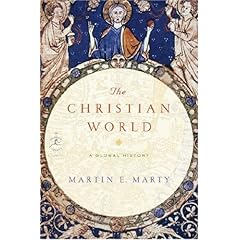
Phillip Jenkins, author of several books chronicling the historic shifts in Christian faith towards the global south, reviews a new book of Church history which gives a balanced attention to the faith's spread and movement in places other than Europe and America. As much as I love Western church history (particularly that of the Reformation) I have longed for a book from which I could read histories of African and Asian Christian movements. Jenkins reviews a volume by Martin Marty entitled The Christian World. This brief volume may just help me on that journey and I clicked my Amazon buttons today to speed its arrival. Here is an exerpt from Jenkins' review:
Even Marty's chapter titles, his "episodes," suggest the scale of the departure from more traditional surveys, which commonly hurry to get the faith to Europe, and then largely ignore the rest of the world until the arrival of those Europeans. Marty, however, pursues a symphonic approach, in which different regions serve as themes and motifs, heard at the beginning and perhaps falling away during later movements, but never forgotten, always ready to recur at significant points of the performance. For Marty, the church of course begins in a Jewish environment, followed by a First Asian Episode, a First African, and a First European. A second European Episode then follows (roughly covering the years since 1500), and then a North American; but then the earlier motifs surface once more, with a Second African Episode and a Second Asian. A thoughtful conclusion stresses the "irrepressible" quality of the Christian venture, and its ability to recoup in one region catastrophic losses suffered in another.
I mean no disrespect to Marty's work when I say that little of the material presented, few of the examples, will come as any great surprise to readers with any background in Christian history. Its value lies instead in its overall construction, and the relative importance allotted to different times and regions, and he has clearly exercised enormous restraint in limiting coverage of Western-centered topics that he knows and loves—the Reformation, the 18th century Awakenings—in order to give due credit to non-Euro-American issues. Many will find the results startling, and that is very much to the good. To take an example, his North American chapter uses a sparse 28 pages to span the whole experience of Christianity in that region since 1492. In comparison, modern Africa receives 19 pages, modern Asia 18, both quite rational allocations in terms of the numbers of believers in those regions today and of their likely importance in the development of the faith in coming years. The Christian World is a bold attempt to make people rethink their basic assumptions of the where and when of a history they may assume they know all too well. To use a rather ugly word, it is a classic exercise in defamiliarization. Marty incidentally, as is well known, never employs ugly words or jargon, and writes throughout in admirably clear, intelligent prose.
I am looking forward to this read and will queue this one up behind my current book of the bedside table...Consuming Jesus, Beyond Race and Class Divisions in a Consumer Church.

